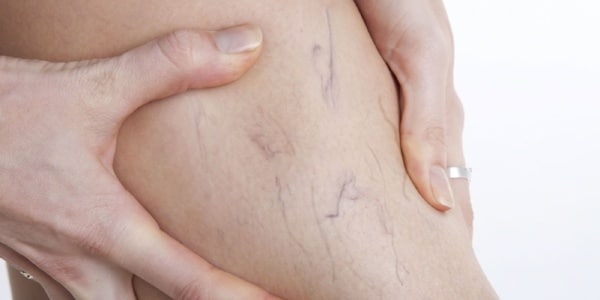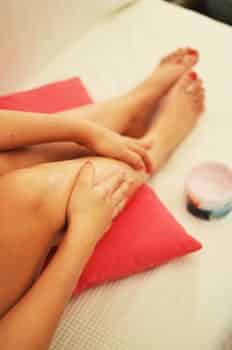
8 Common Myths About Spider Veins
There are a lot of myths and misconceptions when it comes to spider veins. So we asked Jilanne Rose, DPN, ANP-C, a top Metro Phoenix Vein Specialist, to dispel some of the more frequent misconceptions surrounding the cause, risk factors, and treatment of this common vein condition.
Myth #1: Spider Veins are Only Cosmetic
Many people believe that spider veins are unsightly but do not require treatment. Often times, there is underlying venous disease that is a much greater issue.
Myth #2: Spider Veins are Just Part of Getting Older
Although age is one of the risk factors of varicose and spider veins, it’s not the only one and is definitely not the most frequent one. The primary cause of any vein disease is hereditary. In other words, ladies and gentleman, if your mom or grandmother had varicose or spider veins, you are more likely to have them and your age is no longer relevant. In fact, vein disease can start to develop as early as your 20s, and if left untreated, varicose and spider veins will be a natural consequence. Other risk factors include female gender, pregnancy, sedentary lifestyle, being overweight, and having a history of prior leg trauma.
Myth #3: Spider Veins are Strictly a Problem for Women
Incorrect! Spider veins can happen to anyone. It is estimated that as many as 45% of all men will develop some form of venous disease by the time they reach their 60s. The number one cause of varicose veins in both men and women is family history. Lifestyle factors play a significant role as well. If your occupation requires you to stand for long periods, such as medical professionals, factory workers, first responders, sales or restaurant staff, you are more likely to get varicose veins. If you travel and spend long hours flying or driving, or if you sit at a desk for several hours at a time, you are at high risk as well.
Myth #4: Running or Standing Can Cause Spider Veins
Again, this is incorrect. In fact, running, walking or exercise is good for your veins and helps increase circulation. Prolonged standing and sitting in one position does aggravate venous disease and you will notice it more.
Myth #5: Only Overweight People get Spider Veins
Although weight may be a risk factor, a 2015 research article published in Phlebology could not directly link obesity with vein disease, so we can’t really bust that myth. Maintaining a healthy weight and lifestyle can help ease symptoms.
Myth #6: Surgery is the Only Option to Treat Spider Veins
Treatments for venous disease have taken huge leaps forward. Today, there is a range of minimally invasive, maximally effective procedures that can have you back on your feet with a much improved quality of life in very little time. Many of these procedures can be performed in a clinic, on an out-patient basis, with local anesthetic. More often than not, spider veins are treated with non-invasive or minimally invasive techniques that are nearly pain-free.
Myth #7: Vein Treatment is Painful
There was a time when leg vein surgery only referred to procedures such as vein stripping and ligations, painful procedures, likely involving general anesthetic, and definitely involving long and difficult recovery times. There are several modern procedures for varicose veins, spider veins, venous insufficiency and other vascular disease, which, cause minimal pain (if any) and have very fast recovery times. Watch this video from Jilanne Rose to learn more about what you can expect in terms of pain and recovery time .
Myth #8: Vein Treatment is Expensive and Not Covered by Insurance
Many people mistakenly believe that varicose and spider veins are only a cosmetic issue. In reality, the majority of our patients, typically have complaints that indicate an underlying venous condition such as leg pain and/or swelling, restless legs or numbing, tired legs, and leg ulcers. These are real medical problems that significantly impair activities of daily living.
After a full vein exam and ultrasound, patients find that commercial insurance carriers almost always cover vein treatment. Medicare and Medicaid will also cover vein treatment.
Additionally, the latest techniques in Sclerotherapy and Thermal Ablation, are minimally invasive and the costs are considerably lower than what you previously had to pay for a surgery.
It is best to get a complete vein exam and consultation from a qualified vein specialist in order to fully understand your specific circumstances. If you would like to find out if you are at risk of venous insufficiency in the Scottsdale, Phoenix, Mesa or Tempe area, click on the link below to book an appointment.
Q & A Pregunta: ¿Qué es el tiempo de induración? Respuesta: el downtime se basa en gran medida en el tipo de intervención y la severidad de la enfermedad venosa. Independientemente del tipo de intervención, nuestros pacientes reanudan todas las actividades el mismo día que el tratamiento. Algunos tratamientos requieren medias de compresión post-procedimiento, pero…
Read MoreQ & A Question: What is the down time? Answer: Downtime is largely based on the type of intervention and severity of the vein disease. Regardless of the type of intervention, our patients resume all activities the same day as treatment. Some treatments require compression stockings post-procedure, but most times these are worn for comfort and…
Read MoreVenas dolorosas y antiestéticas de las piernas Con el calor de Arizona, un día de verano, día de invierno, o cualquier día es ideal para usar shorts. Pero para aquellos con varices o venas de araña, la idea de usar pantalones cortos es preocupante y lleva a la ansiedad severa. Según el Departamento de salud…
Read MorePainful and unsightly leg veins With the Arizona heat, a summer day, winter day, or any day is ideal for wearing shorts. But for those with varicose veins or spider veins, the thought of wearing shorts is troubling and leads to severe anxiety. According to the U.S. Department of Health and Human Services, 55% of…
Read MorePregunta: ¿dos ultrasonidos Doppler encuentran cualquier coágulo de pierna? (Muslo o pantorrilla). ¿Es el síndrome de mayo-Thurner (MTS) posible y un venography necesario en mi caso?
Read MoreQuestion: Would two Doppler ultrasounds find any leg clots? (Thigh or calf). Is May-Thurner syndrome (MTS) possible and a venography necessary in my case?
Read MoreSi quisiera deshacerse de las venas antiestéticas, las venas de araña, o las varices dolorosas; a continuación, la búsqueda de resultados de escleroterapia, a través de un especialista en la vena, puede ser la elección correcta para ayudar a mejorar su dolor, la felicidad y su apariencia. En este procedimiento rutinario, el médico de la…
Read MoreIf would like to get rid of unsightly veins, spider veins, or painful varicose veins; then pursuing sclerotherapy results, through a vein specialist, may be the right choice to help improve your pain, happiness, and your look. In this routine procedure, your vein doctor injects a chemical into the veins which will cause the veins…
Read MoreParece concebible que cuando los expertos en Salud estiman que el 10 por ciento de las mujeres embarazadas experimentan várices vulvares, es decir, varices vaginales, podrían subestimar groseramente la incidencia de esta afección. Hay mujeres — que saben cuántas — que no reportarán este dolor, picazón, pesadez e incomodidad general en la vulva, ya sea…
Read MoreIt seems conceivable that when health experts estimate that 10 percent of pregnant women experience vulvar varicosities, that is to say vaginal varicose veins, they could be grossly underestimating the incidence of this condition. There are women—who knows how many—who will not report this pain, itch, heaviness and general discomfort in the vulva, either because…
Read More


